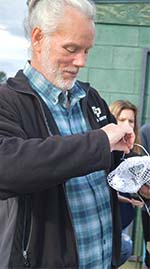Physical science class at Comstock Park High School has become true to its name in recent years. Freshmen spend class time actively immersed in real-life science.
They forecast the weather. They collect data on temperature at different altitudes gauged by a tiny aircraft. They measure the wind direction blowing across the high school baseball field. They calculate water velocity in a nearby river. They model glaciers with crushed ice and dirt. They launch rockets, determining height using a GoPro camera.

The point is not just to teach science but to encourage students to be scientists, collecting real data in the environment, figuring out what it means and drawing conclusions, said science teacher Steve Virkstis.
Filling out worksheets from a textbook is a thing of the past. Instead, the classroom is the the schoolyard, neighborhood park or atmosphere high in the sky.
“When I was in school, it was pretty much about ‘read the textbook, here’s the worksheet, do the work and turn it in,'” Virkstis said. “Now we’re really trying to allow them to do hands-on experiments and collect and manipulate real-time data.”
The approach ties in with the proposed State of Michigan Science Standards. Students become independent thinkers and problem-solvers, realizing real science doesn’t always mean finding the answer. “Your answer might be completely different than someone else’s,” he said.
A true scientist then asks, “Why?”

Turning Data Into Science
Outside on the baseball field, students calculated a complicated-sounding formula called “adiabatic lapse rate,” which, in layman’s terms, means how much temperature drops as altitude increases.
To complete the project, Kent ISD STEM consultant Ebiri Nkugba, a pilot, visited with his unmanned aerial vehicle, commonly called a drone.
Freshman Shyauna McKinney helped operate the aircraft as it reached a height of 400 feet. As the drone buzzed overhead, students also measured how temperature varied on different surfaces — grass, pavement and dirt — to determine how much of the sun’s energy was radiating off the Earth.
They used devices to measure temperature and graphing calculators to track the data.
“This is fun,” Shyauna said. “I hate sitting in the classroom. I like going places and learning new things.”
Sometimes science classes are merged, since all areas of science have components that interplay. Recently, 300 freshman in physical science and sophomores in biology, accompanied by Virkstis and biology teacher Aaron Peoples, visited Wahlfield Park to explore the forest for life forms and plant matter, studying what exists in certain sections of land.
Students also waded into the water to calculate stream depth and width and created a video of a ball riding the currents to calculate water velocity.
Sometimes, students haven’t spent a lot of time exploring the great outdoors, he said. Getting out there exposes them to new things and understanding of science.
“The more we can get kids out into the field and collect data, the more they appreciate science rather than if they are in the classroom all the time,” Virkstis said. “Believe it or not, a lot of them have not been in a forest or spring environment,”

Flipping Things Around
Virkstis’ classes are “flipped,” meaning students watch his videoed lectures and do their note-taking at home. That leaves ample time during the school day to answer students’ questions and get out into the world to discover science beyond the textbook, he said.
“I’d never go back to a traditional model again,” said Virkstis, who has been teaching for 18 years. “I don’t call myself a teacher really, I’m a facilitator.”
With lectures-as-homework out of the way, class is all about applying the lesson. “There’s no reason to just sit in the classroom. We can do these activities to use what they learned,” he said.
Pulling in resources, like drone technology, a visit from a math teacher to explain the math in science and other professionals also helps students make connections.
Freshman Nathan Grytma likes it that way.
“I felt like it was a lot more interactive and fun than learning about it in the classroom,” he said, noting that part of the fun is being with his friends outside or in the water. “It feels like more than a class.”
CONNECT









